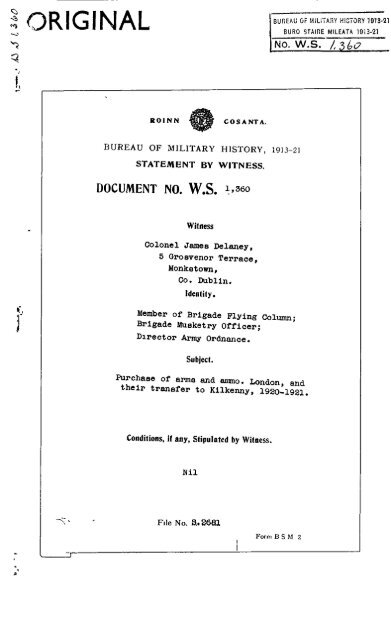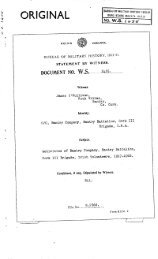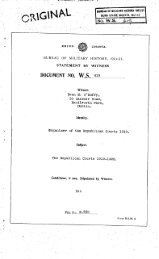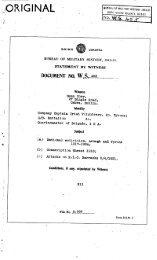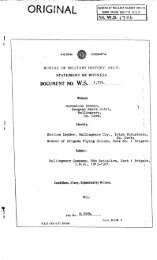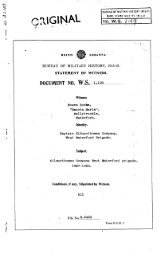ROINN COSANTA. BUREAU OF MILITARY HISTORY, 2913-21 ...
ROINN COSANTA. BUREAU OF MILITARY HISTORY, 2913-21 ...
ROINN COSANTA. BUREAU OF MILITARY HISTORY, 2913-21 ...
Create successful ePaper yourself
Turn your PDF publications into a flip-book with our unique Google optimized e-Paper software.
<strong>ROINN</strong><strong>COSANTA</strong>.<strong>BUREAU</strong> <strong>OF</strong> <strong>MILITARY</strong> <strong>HISTORY</strong>, <strong>2913</strong>-<strong>21</strong>STATEMNT BY WITNESS.DOCUMENT NO. W.S. 1,360WitnessColonel James Delaney,5 GrosvenorTerrace,Monkstown,Co. Dublin.Identity.Member of Brigade Flying Column;Brigade Musketry Officer;Director Army Ordnance.Subject.Purchase of arms and ammo.London, and.their transfer to Kilkenny, l920-192l.Conditions, if any, Stipulatedby Witness.NilFile No. S.2681Form
STATEMENT BY COLONEL JAMES DELANEY,5. Grosvenor Terrace, Monkstown, Co. Dublin.My association with the Irish Republican Army beganin May, 1920, when a number of Irish political prisonerswere on hunger-strike in Wormwood Scrubbs Prison, London.I was living in London at the time, and in the precinctsof the prison I saw the clashes which took place betweenmembers of the London Company of Irish Volunteers and rowdieswho went there to break up demonstrations by women folkof Irish origin Who gathered each evening to recite the Rosarynear the prison gates. Amongst the prisoners who wereon hunger-strike there was one whom I had known from myboyhood days. He was Mr. Thomas Treacy of Dean St.,Kilkenny.The prisoners were released after about two weekson hunger-strike and I visited Mr. (Tom) Treacy in ahospital at Highgate where he was recuperating. I askedhim if there was anything I could do in London to assistthe movement at home, and he enquired if there was anyprospect of getting revolvers and ammunition in Londonand getting them across to an address or addresses inKilkenny which he would send me after his return home.I agreed and, after arranging a code by which we wouldcorrespond, we parted.At the time I was familiar with two Irishmen namedLynch and Cooley. Both were. ex-members of the London police,having been dismissed from the police force for going onstrike. They put me in touch with a London Irishman, abookmaker by the name of Conroy, as a man who might be able
2.to procure arms for sale. Through Conroy I contacted aJewman named Ginger Barnett in Petticoat Lane in the EastEnd and a halt-caste named Darby the Coon. The lattercould best be described as a gang leader. Meanwhile,Tom Treacy had sent me £100 to start off with.With the assistance of Barnett and Darby the Coon,I would say that I managed to purchase two or threerevolvers, or automatics each week. Sometimes they soldthem to me direct, but mostly, with one or the other, Ivisited sailors lodging houses in Petticoat Lane,Limehouse Causeway, Pennyfields (Chinese quarter) and negrolodging houses in Cable St. in the East End. Sailors whomI met in those places were the principal source of supply,and I paid anything from £2 to £4 for each revolver.according to itssizeandcondition.I was staying at the time in a boarding house inGrosvenor Road near Victoria Station, but I never brought anyof the revolvers there. As I got them I handed them overto a Kilkenny girl by the name of Annie O'Gorman who wouldbe waiting to meet me at the Marble Arch. Later, in herresidence, I would wrap the revolvers up in twelve yards oftailors wadding and post the parcel to Kilkenny. I neversent more than one at a time. At first, in accordance withthe arrangements. I had made with Tom Treacy, I addressed theparcels to The Secretary, Electric Lighting Scheme, Town Hall,Kilkenny. This was, of course, a fictitious address,but the Town Clerk in Kilkenny, who knew nothing about thecontents, had been advised by Tom Treacy or the late LeoDardis to bring all parcels so addressed to the late Peterde Loughry in Parliament St. Later, on instructions fromTreacy, I sent the parcels to other addresses in Kilkenny,including that of a cousin of my own.
3.This plan of purchasing the arms in London andgetting them across worked well until November, 1920. ThenI was introduced by a most reliable Irish gir1 who was afriend of Annie O'Gorman, to an Irishman whose name Icannot now recall. This man told me that there were acouple of hundred revolvers in a military store nearVictoria Station. He said they were revolvers which hadbeen handed in by Australian soldiers before their returnto Australia; that he knew one of the storemen intimatelyand that the latter was prepared to bring out some of therevolvers and sell them. I told him that I would buy oneafter he said that he would act as the go-betweenbetween the storeman and myself. He got me one andafter paying him for it I had £50 on hands, so I told himthat I was prepared to take a further 25 at £2 each.He agreed and I made a further appointment to meet himagain at 7 p.m. at Trafalgar Square. He was under theimpression that I would bring the money and an empty suitcasefor the guns to Trafalgar Square. He kept the appointmentbut I had neither the suitcase nor the money with me.After greeting me, he excused himself for a moment andcrossed the road. I was immediately apprehended by twodetectives who came from behind me. They searched meand then took me to Scotland Yard. One of the detectiveswas Chief Inspector McGrath of the C.I.D. He questioned mefor four hours and took a statement from me, in which Idenied point blank that I had any interest in purchasing armsexcept that I was going to Belfast and that, if I could getit, I was prepared to buy one revolver to protect myselffrom both sides while in Belfast. He took my keys and myaddress and I was then put in a cell in Canning St. policestation.
4.The next morning I was taken again to McGrath's office.He handed me back my keys and £50 which I had locked up inmy suitcase in my room of the boarding house in GrosvenorRoad and told me I was free to go. They (the C.I.D.) hadsearched my room during the night but had found nothingwhich would in any way incriminate me. At the timeI had seven revolvers with Annie O'Gorman.The first thing I did after leaving Scotland Yardwas to change my digs from Grosvenor Road to ones inEdgeware Road. I also decided to leave London and to gohome to Kilkenny. I got in touch with Miss O'Gorman andmet her at the Marble Arch, when I explained the position toher. I told her I would take three of the revolvers with me,and I asked her to wrap up the other four exactly as shehad seen me do it and to post them singly to addresses inKilkenny which I gave her.One of the revolvers which I took with me was aWebley Service revolver and I fasted it between the backbuttons of my trousers with the barrel pointing up my tack.Another was a short parabellum, which I broke down into itscomponent parts and sewed them into the hem at the bottomof my overcoat. The third was a small 32 automatic,and this I sewed into a shoulder pad of my overcoat.I travelled via Holyhead and Dunlaoghaire, and except thatmy luggage was searched at Holyhead I reached Kilkennywithout incident, where I handed over the three revolversto Tom Treacy and gave him an account of what had happenedto me in London. As regards the four revolvers which Ihad left behind with Miss O'Gorman, one reached itsdestination safely. The second one she sent reached the
5.sorting office in the post office, Kilkenny. Here a postoffice assistant named O'Driscoll saw the butt of itprotruding from the wadding and wrapping. He handed theparcel over to the Ptstmaster, who reported it to the B.I.C.It was addressed to a girl in the Cloth Hall, Kilkenny,who knew nothing about it beyond the fact that when theparcel arrived she was to hand it over to Kieran Tobin,who was then a Volunteer officer in Kilkenny. Thisdiscovery led to the girl's. arrest, and it must also haveled to the discovery in the post of the other two, foralthough both were posted in London by Miss O'Gormanthey were never delivered in Kilkenny. Thus finisheduntil after the Truce the purchasing of arms by me fortheI.R.A.A few weeks. after my return to Kilkenny I madeapplication to be posted to an active service unit.However, the rearrest of Tom Treacy and the arrest ofPeter de Loughry and several other officers of the KilkennyBrigade resulted in delay. There were two active serviceunits in the Kilkenny area at the time. One was basedon the Callan-Tipperary border, and the other was inSouth Kilkenny, based on Graiguenamanagh. The KilkennyCity Battalion had no active service unit and there was nosection from Kilkenny City serving with either of the twobrigade active service units. Eventually, about February,19<strong>21</strong>, the late Leo Dardis, who was then Vice Commandant ofthe Kilkenny Brigade, told me that arrangements had beenmade to have me posted to the active service unit inSouth Kilkenny and that I was to proceed to Graiguenamanagh.He arranged an appointment for me with Martin Mulhall ofGoslington, who was then Commandant of the 1st Battalion,
6.Kilkenny Brigade. I met Mulhall near his own house on aSaturday night. He administered the oath to me, issued mewith a rifle and 50 rounds of 303 ammunition and gave me aguide to conduct me part of the way to Graiguenamanagh.Other guides took me over in turn and I covered the fifteenodd miles on foot, reaching Graiguenamanagh on Sundaymorning.On arrival I was informed by the local Battalion Staffthat the column was then away on operations in NorthKilkenny and that I was to await their return and stayin the meantime at Keating's of Ballyheagan. in aboutthree weeks the column returned. The late George Dwyer,then the Brigade Commandant, normally was in command.He was, however, absent in Dublin, and Michael O'Carrollof Graiguenamanagh (now of Thomastown, Co. Kilkenny) wasacting as column leader. The strength of the column whenI joined it was eleven men, excluding the Brigade 0/C, GeorgeDwyer. Their names were as follows:Michael O'Carroll, GraiguenamanaghJack Walsh do.Christopher Doyle do.James. Doyle do.Robert Doyle do.Patrick Quinn do.Martin Bates, The RowerMichael O'Hanrahan, InistiogueJack Hartley, GlenmoreNicholas. Mullins, ThomastownJames Purcell, Goresbridge.Some weeks. after the return of the column to Graiguenamanaghthe following men reported for duty from the Kilkenny CityBattalion:Edward Holland, TullaroanJohn Wall, ThreecastlesKoran Cody, KilkennyJohn Keane, KilkennyMichael Ruth, KilkennyMichael McSweeney, KilkennyKieran Tobin, Kilkenny.
7.Life on the column was very uneventful until aboutJune, 19<strong>21</strong>. We spent a lot of our time on the slopes ofBrandon Hill, the roads around which were used by theAuxiliaries from Woodstock House, Inistiogue, but we couldnever catch them in an ambush position. Then early inJune, 19<strong>21</strong>, we moved on foot up into North County Kilkenny.The route as we went would, I should say, be approximately35 miles. I am not familiar with the place-names aroundNorth County Kilkenny, but, as far as I can remember, it wasnear Coon we met George O'Dwyer. He told us that heproposed to attack on the following Saturday morninga party of British troops which usually (on Saturdaymornings) escorted explosives from Castlecomer militarybarracks to the coal mines. This party generally consistedof a military lorry with the explosives and followed by anescort of troops in two Crossley tenders. The pointselected for the ambush was at Coolbawn, about a milefrom Castlecomer on the main Castlecomer-Athy road.For this operation about 30 local Volunteers, armedwith shotguns, were mobilised1 to reinforce the column.About 3 a.m. on the Saturday morning work began on thelaying of a mine In the centre of the road. This task wascompleted by 6 a.m. when all parties moved into theirpositions. I was put in charge of a party of 10 men, someof whom were members of the column and the remainderlocal men with shotguns. My position was in the centre ofthe ambush but about 6o or 70 yards to the left of where themine had been placed on the road. On my right and almostopposite to the mine, George O'Dwyer and Gerald Brennan(now Deputy Commissioner of the Garda Siochána) occupied aposition with a similar party, and a third party of about thesame strength were on my left. Nicholas Mullins, Jack
8.Hartley and James Doyle of the column were with this latterparty. All three parties were behind a low wall or bankon the right-hand side of the road as one comes fromCastlecomer. To our rere there was a steep decline inthe ground towards a ravine, beyond which the ground rosesharply to a height. Here, too, there was an abundance ofshrubbery and small woods. On the opposite side of the roadthere was a steep incline in the ground up from the roadside.Scouts were placed on the high ground on both sides of theambush position and, with the aid of field glasses, kept themilitary barracks in Castlecomer under observation.The lorries were expected to leave Castlecomer about10 a.m. and the plan was that the party on my left wouldallow the first two to pass them and attack the third.I was to allow the first lorry to go on to the mine andattack the second one. The mine was to be explodedwhen the first lorry came over it, and it (the lorry) wouldthen be attacked by the party on my right. This planlooked reasonably good to me, provided, of course, that thelorries came the way we expected them to come. Inaddition to my rifle and revolver, I had 6 grenades (G.H.Q.pattern) which I proposed to use myself. The range to thecentre of the road from my position was about six yards.Our total frontage along the right side of the road was about300 yards.From early morning horse-drawn carts of coal fromthe coal mines came along the road. These were diverteddown a side road on our right, where the horses were tiedand the drivers were taken to a house and kept under guard.Similar precautions were taken in the case of any other peoplewho came along.
9.The morning wore on but no sigh of the lorries coming.The scouts, however, kept reporting to O'Dwyer that thelorries were in the barracks and were moving around frombuilding to building as. if loading up. Nothing happeneduntil the early afternoon, and then the first intimationI had that all was not well was when I heard a shout froma member of the column on my right: "Retire, we aresurrounded on all sides". Almost simultaneously there wasa burst of fire opened by British troops from a wood on myleft rere. I imagine it was this first burst of firewhich killed Nicholas Mullins and Jack Hartley, whom, asI have already mentioned, were with the party on my left.I collected my rifle and the grenades and, bringingmy ten men with me, I ran down the incline and into a woodat my rere. This wood had not yet been occupied by theBritish troops and, passing through it, we reached thehigh ground beyond the ravine. Here my party was joinedby some other members of the column, including GeorgeO'Dwyer and some of the local men. We entered a grove ofyew trees and lay down. Beyond this1 grove it was all opencountry and we could not move out, so we remained thereuntil darkness came that night. it was surprising thatthe British troops remained unaware of our position in thislittle isolated grove.. There were at least 20 men in itand it was not more than 300 yards from the ambush position.We could hear lorries on the road as more British troopsarrived from Kilkenny and other towns within a radius of 12to 15 miles. We heard them firing and exploding the mineon the road, but they made no move to come near the grovewhere we lay. After dark we moved away across countrytowards the County Carlow border, where we remained for theremainder of the night. in addition to Mullins and Hartley,
10.we suffered one other casualty- James Doyle- who apparentlytried to cross the road and was seriously wounded andcaptured.A word of explanation as to how. the British troopscame to surprise us is necessary. Subsequently I learned thefacts. Our guards who were looking after the civiliandetainee5 down the side road permitted a workman to proceedto his place of employment which was only a very shortdistance away. This man told his employers- two sistersnamed Dreaper - that he had been held up by armed men on theroad and, I presume, he gave them an account of all he hadseen. One of the Miss Dreapers went on horseback alongthe railway line into Castlecomer and informed the Britishmilitary of our presence on the main road. The Britishofficers in Castlecomer must have had little difficulty inguessing what we were waiting for and laid their plansaccordingly. The fact that the lorries which usuallycarried the explosives and escort moved, around thebarracks in their normal way would indicate that theofficers knew, or assumed, that the barracks was underobservation. The troops, who came out of the barracks onfoot and surprised us must have been got out secretly andin small parties, for our scouts noticed no massedmovement of troops leaving the barracks. Miss Dreaper'shouse was subsequently burned by the I.R.A. as a reprisalfor her act of treachery.After Coolbawn, O'Dwyer divided the column intosections.. The Kilkenny City members of it were formedinto one section, and he placed me in charge of it with therank of Lieutenant.. There were, however, no incidentsworth recording from then until the Truce in July, 19<strong>21</strong>.
11.Shortly before the Truce he again promoted me, this time tothe rank of Captain, with an appointment as BrigadeMusketryinstructor.During the Truce period I was the chief instructorat the brigade training camp, and during this period Ialso paid two visits to London to purchase arms for thebrigade. During my first visit I purchased about 30 or 40revolvers. I was in London on mysecond visit when theArticles of Agreement were signed on December 6th, 19<strong>21</strong>.On the following morning I received a messagefromGeorgeO'Dwyer to return to Kilkenny at once and not to make anyfurther arrangements regarding the purchase of arms.After the Treaty was signed I acted as BrigadeLiaison Officer in Kilkenny and continued to act in thiscapacity until March, 1922, when the British forcesevacuated Kilkenny military barracks. I then reported atBeggars Bush Barracks, Dublin, where I was given acommission in the Regular Army.Signed:JamesDelaney Colonel(James Delaney) Colonel.Date: 2nd March 1956.2nd March 1956.Witness: J Grace(J.Grace)


